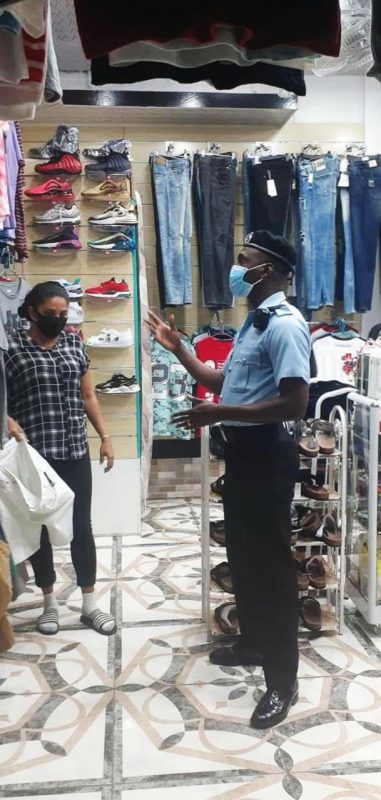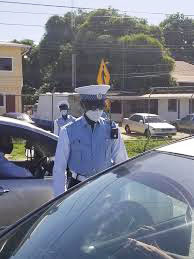With optimism that the use of Portable Video Recording (PVR) devices also known as body cameras will not only increase accountability, transparency and public trust but also influence the behaviour of its ranks, the Guyana Police Force (GPF) has been actively employing the equipment in its daily operations.
Currently, the force has a total of 180 body cameras and Minister of Home Affairs Robeson Benn said that plans are in the pipeline to source another 500 with the funds allocated in the 2021 Budget.
In a recent interview with Stabroek News, officer-in-charge of the GPF Information Technology (IT) Department, Senior Superintendent Jermaine Johnson said that the equipment has been distributed among all the policing divisions across the country.
He said they are being used by ranks of the traffic department, anti-crime patrols, riot units, in courts and on general duty.
Johnson explained that the implementation of the use of the body cameras is aimed at benefitting both the force and the public. He said it may improve public behaviour and also help protect officers from false complaints
Often, Johnson said ranks are called upon to address situations with violent, unpredictable individuals. “Tragically, police can and do get killed in the line of duty”, he said.
He added that although body cameras do not necessarily influence police behaviour when under pressure, they are designed to improve their safety. “When individuals know they are being recorded, people are more likely to behave less aggressive than if they aren’t being recorded or don’t know that they are being recorded,” Johnson noted.
Johnson said that the equipment is a step forward in increasing public confidence and developing better relations with the public.
Ranks using body cameras are guided by Standard Operating Procedure (SOP) 1- of May 2015.
This sets out guidelines and procedures for the use, management, access, retention and handling of evidence, storage and retrieval of recorded media captured by PVR equipment during the execution of official duties.
Corruption and bribery
While they are seen as important in ensuring accountability by police ranks during sensitive operations and for evidential purposes, they are also aimed at reducing certain types of cases,
particularly corrupt practices while producing live evidence of day-to-day interactions.
Additionally, they are intended to help ranks with recalling facts and other details captured by the equipment that would accurately recount the chain of events when writing reports.
From time to time, there would be instances whereby ranks are fingered and even charged for receiving a bribe or being involved in corrupt practices.
During a telephone interview with this newspaper recently, Benn said that he believes that the technology “may” help with these issues.
“The policeman has to be pretty brave to go out doing a corrupt deal if he has a body camera on,” he said.
According to Benn, these issues have to be dealt with more at the level of citizen reporting by the citizens videoing the actions of ranks. “….I said people should video the actions of the police and vice versa, the police should video interactions with the public,” Benn urged.
Benn noted that the goal is to install cameras at police stations so that the interactions with the police and public can be recorded.
Meanwhile, Shadow Minister of Home Affairs, Geeta Chandan-Edmond told this newspaper that the technology can “certainly” help in these instances if operated in a structured way with independent oversight.
“As long as police continue to investigate themselves, it is difficult to fight corruption in the force,” Chandan-Edmond stated.
However, she noted that mechanisms must be in place to ensure that cameras are not tampered with. “To tamper with the cameras will defeat the intended purpose,” she said.
In October last year, a policeman was arrested during a sting operation after he was allegedly caught soliciting money from a member of the public who wished to avoid prosecution.
Months before this, an Assistant Superintendent of Police (ASP) was accused of taking a bribe of $100,000 to make a statutory rape charge disappear in Berbice.
Senior ranks have also faced accusations.
One such example was when former Crime Chief, Deputy Commissioner of Police Lyndon Alves was being investigated for alleged corrupt practices back in 2019.
In late June 2019, Alves was placed on administrative leave pending the outcome of an investigation into the exposure of a network of alleged corruption in the Berbice district. He was subsequently cleared of any criminal conduct.
Currently, a financial audit is ongoing into the GPF Finance Department after it was discovered that $300M was missing. A number of ranks, including senior officers have since been sent on administrative leave to facilitate this probe.
On Friday, the police said that persons found culpable of any “illegality” will face the full force of the law.
Training
Johnson said that members of the force are being trained to use the body cameras and only those who received training are entitled to operate one.
“Officers must receive training in the use of the PVR by an authorized rank of the IT department and only those officers that have received the department-authorized training may operate a PVR,” he said.
In the past, the police had also held several training sessions for this purpose.
Johnson said for ranks who are tasked with using the body cameras while on duty but refuse, disciplinary measures will be taken against them.
Chandan-Edmond, a former magistrate, told Stabroek News she supports the use of any form of technology that is administered under the “strictest” supervision, training and the establishment of protocols which will ensure the effective use of the cameras.
“So while body cameras may have an impact on the behaviour of police officers, proper education and a change in organizational mindset is of primary importance while police may see the camera as a tool for the collection of evidence, public confidence in the police in relation to the reduction in the use of force may not necessarily emerge in the short term,” she explained.
She said that it is her hope that the Ministry of Home Affairs takes a “structural” approach to the use of this technology.
This, she said, includes them ensuring that there is a clear concept note and policy document to guide the use of the body cameras coupled with a six-month monitoring and evaluation plan on the implementation of use of the cameras.
“It is my hope that this results in the documentation of their activities. In the event that there is a dispute over incidents between citizens and members of the Guyana Police Force, I expect this technology to aid in the establishment of the facts, promote efficiency and aid in the safety of the officers,” Chandan-Edmond said.
In providing details of the body cameras, Johnson explained that the force has two types namely the Pro-vision and TD TECH.
The Pro-vision, he said, supports up to 256 GBs memory while the TD TECH has a built-in capacity of 32 GB.
According to Johnson, the IT department has the responsibility to copy all recordings from the equipment and store it in the data centre.
The copy, Johnson said must be verified by the owner of the equipment at the time and made in their presence.
There is a format under which the recordings are stored. The format includes a serial number and the name of the ranks, both who used and copied it. The date and time are also included.
After the digital copy of the recording is made, the equipment is then returned to the rank.








